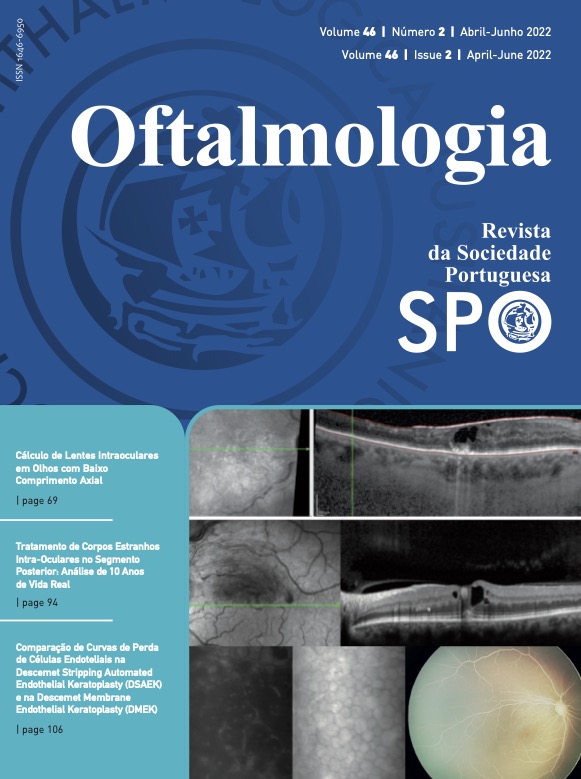Preditores Morfológicos de Resposta ao Bevacizumab Intravítreo para Tratamento do Edema Macular Secundário a Oclusão Venosa da Retina
DOI:
https://doi.org/10.48560/rspo.22578Palavras-chave:
Bevacizumab, Edema Macular, Oclusão Venosa da Retina, Tomografia de Coerência ÓpticaResumo
INTRODUÇÃO: O nosso objetivo foi identificar preditores morfológicos de resposta anatómica e funcional a curto prazo ao tratamento do edema macular (EM) secundário a oclusão de ramo (OVRR) e da veia central da retina (OVCR) com bevacizumab.
MÉTODOS: Estudo retrospetivo de doentes com EM secundário a OVRR e OVCR sob tratamento mensal com injeções intravítreas de bevacizumab. Apenas doentes treatment naïve e com edema macular central com ≥305 μm nas mulheres ≥320 μm em homens na tomografia de coerência óptica (SD-OCT) (Heidelberg Spectralis OCT; Heidelberg Engineering, Heidelberg, Germany) foram incluídos. A resolução do EM foi definida como uma espessura macular central inferior a 300 μm e ausência de líquido intra e subretiniano. Foram colhidos dados demográficos, relativos à melhor acuidade visual corrigida (MAVC) na escala ETDRS e as imagens do SD-OCT foram analisadas na baseline e aos 4 meses. As imagens do SD-OCT, no anel de 1,0 mm central, foram analisadas quanto à presença de: desorganização das camadas internas da retina (DRIL), disrupção da zona elipsoide (ZE) e da membrana limitante externa (MLE), presença e localização de focos hiperrefletivos intrarretinianos (HRF), líquido intra e subretinano e status da interface vítreo-retiniana.
RESULTADOS: Foram incluídos 61 olhos de 61 doentes, dos quais 29 (47,5%) apresentaram OVCR e 32 (52,5%) OVRR. Aos 4 meses o número médio de injeções intravítreas realizadas foi de 3,2±2,7 injeções. A MAVC melhorou de 32±27 letras ETDRS na baseline para 44±27 letras ETDRS aos 4 meses (p<0,001). A melhoria da MAVC foi idêntica em olhos com OVCR e OVRR (p = 0,680). Uma MAVC inferior na baseline correlacionou-se com um maior ganho de letras ETDRS ao fim de 4 meses (r = -0,45, p<0,001). A MAVC aos 4 meses foi significativamente mais baixa nos indivíduos que apresentavam na baseline presença de DRIL (39±27 vs 64±17 ETDRS letras, p=0,006), disrupção da ZE (40±26 vs 64±21 letras ETDRS, p=0,016) e da MLE (40±2 vs 64±20 6 letras ETDRS, p=0,016). Os pacientes que apresentavam DRIL na baseline têm em média menos 25,2 letras na MACV ao fim de 4 meses (Intervalo de confiança [IC] 95%, 8,1 – 42,3; p=0,004). Do mesmo modo, a disrupção da ZE e da MLE predizem uma diminuição de 24,5 letras na AV final (EZ IC 95%, 5,6 – 43,5; p=0,010; MLE IC 95%, 5,6 – 43,5; p=0,010). Vinte e três (37,7%) doentes apresentaram resolução completa do EM aos 4 meses. O número de olhos com resolução de EM foi semelhante entre aqueles com OVCR e OVRR (p = 0,590). Nenhum dos fatores clínicos ou morfológicos analisados na baseline foram preditivos de resolução do EM. No entanto, ausência de DRIL (p = 0,003), presença de HRF nas camadas internas da retina (p <0,001) e integridade da ZE (p = 0,03) e MLE (p = 0,004) foram significativamente mais frequentes entre aqueles com resolução do EM.
CONCLUSÃO: O tratamento do EM secundário a OVCR e OVRR com injeções intravítreas de bevacizumab traduziu-se em ganho anatómico e funcional significativo. No nosso estudo, doentes com DRIL e disrupção da ZE e MLE na baseline apresentaram uma MAVC inferior no follow-up. A identificação de biomarcadores que antecipem a resposta do EM ao tratamento com anti-VEGF ajudará a programar o tratamento destes doentes e, adicionalmente, permitirá a estratificação e o estabelecimento do prognóstico da doença.
Downloads
Referências
Schmidt-Erfurth U, Garcia-Arumi J, Gerendas BS, et al. Guidelines for the Management of Retinal Vein Occlusion by the European Society of Retina Specialists (EURETINA). Ophthalmologic. 2019;242:123-62. doi: 10.1159/000502041.
Jaulim A, Ahmed B, Khanam T, Chatziralli IP. Branch retinal vein occlusion: epidemiology, pathogenesis, risk factors, clinical features, diagnosis, and complications. An update of the literature. Retina. 2013;33:901-10. doi: 10.1097/ IAE.0b013e3182870c15.
Ophthalmologists. TRCo. Retinal Vein Occlusion (RVO) Guidelines. 2015. [Accessed November 2019]. Available from: https://www.rcophth.ac.uk/wp-content/uploads/2015/07/Ret- inal-Vein-Occlusion-RVO-Guidelines-July-2015.pdf.
Spaide RF. Retinal vascular cystoid macular edema: Review and New Theory. Retina. 2016;36:1823-42. doi: 10.1097/ IAE.0000000000001158.
Daruich A, Matet A, Moulin A, Kowalczuk L, Nicolas M, Sellam A, et al. Mechanisms of macular edema: Beyond the surface. Prog Retin Eye Res. 2018;63:20-68. doi: 10.1016/j.pre- teyeres.2017.10.006.
Ehlers JP, Kim SJ, Yeh S, Thorne JE, Mruthyunjaya P, Schoenberger SD, et al. Therapies for Macular Edema Associated with Branch Retinal Vein Occlusion: A Report by the American Academy of Ophthalmology. Ophthalmology. 2017;124:1412-23. doi: 10.1016/j.ophtha.2017.03.060.
Sangroongruangsri S, Ratanapakorn T, Wu O, Anothaisintawee T, Chaikledkaew U. Comparative efficacy of bevacizumab, ranibizumab, and aflibercept for treatment of macular edema secondary to retinal vein occlusion: a systematic review and network meta-analysis. Expert Rev Clin Pharmacol. 2018;11:903-16. doi: 10.1080/17512433.2018.1507735.
Brown DM, Heier JS, Clark WL, Boyer DS, Vitti R, Berliner AJ, et al. Intravitreal aflibercept injection for macular edema secondary to central retinal vein occlusion: 1-year results from the phase 3 COPERNICUS study. Am J Ophthalmol. 2013;155:429-437.e427. doi: 10.1016/j.ajo.2012.09.026.
Korobelnik JF, Holz FG, Roider J, Ogura Y, Simader C, Schmidt-Erfurth U, et al. Intravitreal Aflibercept Injection for Macular Edema Resulting from Central Retinal Vein Occlusion: One-Year Results of the Phase 3 GALILEO Study. Ophthalmology. 2014;121:202-8. doi: 10.1016/j.ophtha.2013.08.012.
Campochiaro PA, Brown DM, Awh CC, Lee SY, Gray S, Sa- roj N, et al. Sustained benefits from ranibizumab for macular edema following central retinal vein occlusion: twelve-month outcomes of a phase III study. Ophthalmol. 2011;118:2041-9. doi: 10.1016/j.ophtha.2011.02.038.
Campochiaro PA, Wykoff CC, Singer M, Johnson R, Marcus D, Yau L, et al. Monthly versus as-needed ranibizumab injections in patients with retinal vein occlusion: the SHORE study. Ophthalmology. 2014;121:2432-42. doi: 10.1016/j.ophtha.2014.06.011.
Scott IU, VanVeldhuisen PC, Oden NL, Ip MS, Blodi BA, Jumper JM, et al. SCORE Study report 1: baseline associations between central retinal thickness and visual acuity in patients with retinal vein occlusion. Ophthalmology. 2009;116:504-12. doi: 10.1016/j.ophtha.2008.10.017.
Campochiaro PA, Clark WL, Boyer DS, Heier JS, Brown DM, Vitti R, et al. Intravitreal aflibercept for macular edema following branch retinal vein occlusion: the 24-week results of the VIBRANT study. Ophthalmology. 2015;122:538-44. doi: 10.1016/j.ophtha.2014.08.031.
Lashay A, Riazi-Esfahani H, Mirghorbani M, Yaseri M. Intra- vitreal Medications for Retinal Vein Occlusion: Systematic Review and Meta-analysis. J Ophthalmic Vis Res. 2019;14:336-66. doi: 10.18502/jovr.v14i3.4791.
Ko J, Kwon OW, Byeon SH. Optical coherence tomography predicts visual outcome in acute central retinal vein occlusion. Retina. 2014;34:1132-41. doi: 10.1097/IAE.0000000000000054.
Brynskov T, Kemp H, Sørensen TL. Intravitreal ranibizumab for retinal vein occlusion through 1 year in clinical practice. Retina. 2014;34:1637-43.
Iftikhar M, Mir TA, Hafiz G, Zimmer-Galler I, Scott AW, Solomon SD, et al. Loss of Peak Vision in Retinal Vein Occlusion Patients Treated for Macular Edema. Am J Ophthalmol. 2019;205:17-26. doi: 10.1016/j.ajo.2019.03.029.
Chan EW, Eldeeb M, Sun V, Thomas D, Omar A, Kapusta MA, et al. Disorganization of Retinal Inner Layers and Ellipsoid Zone Disruption Predict Visual Outcomes in Central Retinal Vein Occlusion. Ophthalmol Retina. 2019;3:83-92. doi: 10.1016/j.oret.2018.07.008.
Berry D, Thomas AS, Fekrat S, Grewal DS. Association of Disorganization of Retinal Inner Layers with Ischemic Index and Visual Acuity in Central Retinal Vein Occlusion. Ophthalmol Retina. 2018;2:1125-32. doi: 10.1016/j.oret.2018.04.019.
Costa JV, Moura-Coelho N, Abreu AC, Neves P, Ornelas M, Furtado MJ. Macular edema secondary to retinal vein occlusion in a real-life setting: a multicenter, nationwide, 3-year fol- low-up study. Graef Arch Clin Exp Ophthalmol. 2021;259:343- 50. doi: 10.1007/s00417-020-04932-0.
Ota M, Tsujikawa A, Kita M, Miyamoto K, Sakamoto A, Yamaike N, et al. Integrity of foveal photoreceptor layer in central retinal vein occlusion. Retina. 2008;28:1502-8. doi: 10.1097/IAE.0b013e3181840b3c.
Shin HJ, Chung H, Kim HC. Association between integrity of foveal photoreceptor layer and visual outcome in retinal vein occlusion. Acta Ophthalmol. 2011;89:e35-40. doi: 10.1111/j.1755-3768.2010.02063.x.
Kang J-W, Lee H, Chung H, Kim HC. Correlation between optical coherence tomographic hyperreflective foci and visual outcomes after intravitreal bevacizumab for macular edema in branch retinal vein occlusion. Graefes Arch Clin Exp Ophthalmol. 2014;252:1413-21. doi: 10.1007/s00417-014-2595-5.
Mimouni M, Segev O, Dori D, Geffen N, Flores V, Segal O. Disorganization of the Retinal Inner Layers as a Predictor of Visual Acuity in Eyes With Macular Edema Secondary to Vein Occlusion. Am J Ophthalmol. 2017;182:160-7. doi: 10.1016/j.ajo.2017.08.005.
Bolz M, Schmidt-Erfurth U, Deak G, Mylonas G, Kriechbaum K, Scholda C. Optical coherence tomographic hyperreflective foci: a morphologic sign of lipid extravasation in diabetic macular edema. Ophthalmology. 2009;116:914-20.
Chatziralli IP, Sergentanis TN, Sivaprasad S. Hyperreflective foci as an independent visual outcome predictor in macular edema due to retinal vascular diseases treated with intravitreal dexamethasone or ranibizumab. Retina. 2016;36:2319-28. doi: 10.1097/IAE.0000000000001070.
Spooner K, Fraser-Bell S, Hong T, Chang A. Prospective study of aflibercept for the treatment of persistent macular oedema secondary to retinal vein occlusions in eyes not responsive to long-term treatment with bevacizumab or ranibizumab. Clin Exp Ophthalmol. 2020;48:53-60. doi: 10.1111/ceo.13636.
Yu JJ, Thomas AS, Berry D, Yoon S, Fekrat S, Grewal DS. As- sociation of Retinal Inner Layer Disorganization With UltraWidefield Fluorescein Angiographic Features and Visual Acuity in Branch Retinal Vein Occlusion. Ophthalmic Surg Lasers Imaging Retina. 2019;50:354-64. doi: 10.3928/23258160- 20190605-03.
J Jaissle GB, Szurman P, Feltgen N, Spitzer B, Pielen A, Rehak M, et al; Retinal Vein Occlusion Study Group. Predictive factors for functional improvement after intravitreal bevacizumab therapy for macular edema due to branch retinal vein occlusion. Graefes Arch Clin Exp Ophthalmol. 2011;249:183- 92. doi: 10.1007/s00417-010-1470-2.
Jaissle GB, Szurman P, Bartz-Schmidt KU; German Retina Society; German Society of Ophthalmology; German Professional Association of Ophthalmologists. Empfehlung für die Durchführung von intravitrealen Injektionen -- Stellungnahme der Retinologischen Gesellschaft, der Deutschen Ophthalmologischen Gesellschaft (DOG) und des Berufsverbands der Augenärzte Deutschland (BVA). Klin Monbl Augenheilkd. 2005;222:390-5. doi: 10.1055/s-2005-858231.
Vaz-Pereira S, Marques IP, Matias J, Mira F, Ribeiro L, Flores R. Real-World Outcomes of Anti-VEGF Treatment for Retinal Vein Occlusion in Portugal. Eur J Ophthalmol. 2017;27:756-61. doi: 10.5301/ejo.5000943.
Downloads
Publicado
Como Citar
Edição
Secção
Licença
Direitos de Autor (c) 2022 Revista Sociedade Portuguesa de Oftalmologia

Este trabalho encontra-se publicado com a Creative Commons Atribuição-NãoComercial 4.0.
Não se esqueça de fazer o download do ficheiro da Declaração de Responsabilidade Autoral e Autorização para Publicação e de Conflito de Interesses
O artigo apenas poderá ser submetido com esse dois documentos.
Para obter o ficheiro da Declaração de Responsabilidade Autoral, clique aqui
Para obter o ficheiro de Conflito de Interesses, clique aqui





